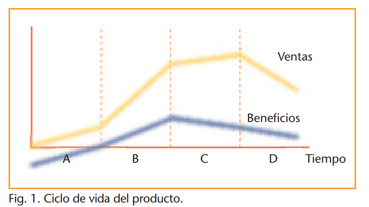what are the stages of a product's life cycle?
Index Content
The life cycle is the process that a product goes through from its origin to its disappearance from the market. It is, therefore, a chronological event that goes through different stages (introduction, growth, maturity, decline and disappearance) in which factors such as sales, profits and competitors are analysed.
It is usually represented by a graph where an independent variable, time, and a dependent variable, sales, are analysed. It is also possible to analyse several dependent variables, such as income, expenses or profits. The general tendency of this graph is to grow gradually from zero, reach a maximum profit point and, finally, suffer a sharper fall than the previous rise.
Luis Godás, OFRAM, The Product Life Cycle.
Companies use this process to try to systematise sales and products and to be able to create a constant and standardised organisational system. It is also a good way of organising to understand the relationship between the product life cycle and the elements of marketing (Product, Price, Distribution and Promotion) .
In the following, we will go deeper into the different stages of the product life cycle.
Introduction
- Introduction or development is the first step. The product has been designed and is then launched on the market for the first time. The product life cycle is usually studied in new products, not in versions or imitations of an existing product.
- It is a difficult and critical stage, where there may be barriers in the market that prevent a successful introduction, which is why 50-70% of products fail at this stage .
- Due to the novelty, sales and profits are still low, even going through a first stage of negative profitability, where revenues do not exceed costs.
- It is essential that, given the novelty of the product, potential customers are aware of its properties, benefits, points of sale...
- It is, at a numerical level, a stage of great economic and technical investment
- As it is a new product on the market, there are still no competitors.
Growth
- Reaching this stage implies that the market introduction has been overcome and the number of buyers increases.
- There is a rapid increase in sales and profits; in fact, the highest profit point of the whole life cycle is reached. However, this is a stage of high costs and reinvestment of those profits.
- Advertising investment continues, mainly due to the fact that this is usually a stage in which the product and its qualities are still being worked on, and new versions are often created and need to be advertised.
- At the same time, advertising investment responds to the emergence of competitors called upon by the notoriety and success of the new product.
- In order not to lose position, sales out lets and distribution channels are intensified at this stage (which also contributes to the increase in costs mentioned above).
Maturity
- Maturity implies the end of product growth, i.e. the highest point of sales, revenues and profits has been reached and, although this stage is characterised by great stability (almost constant graphical line), it is expected that the variables analysed will begin to decline from now on.
- Profitability continues, of course,to be positive. Although the number of sales does not grow, brand and product loyalty means that large investments in advertising are unnecessary, which means cost savings.
- Despite loyalty, this is a phase where the company encounters a high number of competitors.
- Research continues and it is often at this stage that new uses for the product are found.
- Prices may start to fall, due to declining demand.
- This is the longest stage of the life cycle and is where almost all products in the market are found.
Decline
- This is the stage at which the graph begins to decline, with sales becoming lower and lower, causing profits and production levels to fall.
- Prices, now stabilised, start to fall, but this is not an absolute trend, as sometimes the disappearance of other competitors can cause prices to rise again.
- advertising investment is minimal. The number of sales is a function of consumer loyalty and loyalty to the company and the product.
- Not all companies are aware that they have reached this stage, as a decline in profits and sales may be due, in addition to the decline stage, to the emergence of newer competitors, a change in consumer preference, etc.
Disappearance
- Finally, it is decided to withdraw the product from the market because of low levels of sales, ergo revenue and profits.
- Discontinuing a product is sometimes necessitated by the development of a newer, improved version, repurposing the product or finding another functionality that will appeal to other consumers.
It is precisely through the product life cycle that some strategies can be implemented to revitalise a product that is beginning to disappear. Improvements can be made in price, quality and product features that either boost the number of sales again or, in other cases, precipitate the product's exit from the market to make way for a new version that can no longer be considered a variation of the previous product. In other words, sometimes it is the company itself that causes the decline of a product in the market to make way for its next creation.
However, the product life cycle is a theoretical approach which, although it has a practical application, does not imply that all products go through all the stages in the same way. There are, as we said, some products that do not go beyond the market introduction stage, others that have an exponential growth and an abrupt fall and others that remain almost for life in the market.
The study of the product life cycle is interesting as a market strategy because it takes into account the competitors. After all, the product is one of the most important elements of the company and knowing its life cycle is fundamental.





